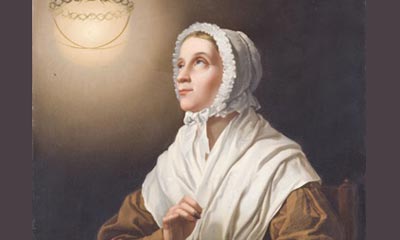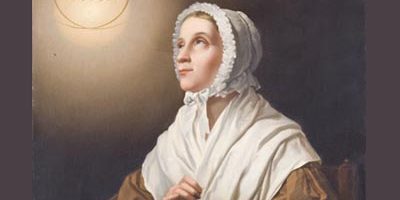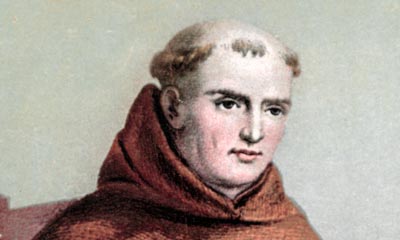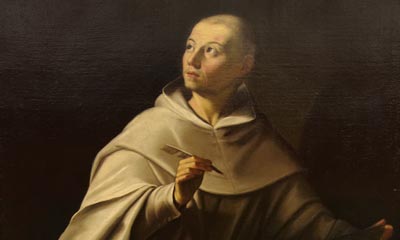July 5, 2023
Blessed Anna Maria Taigi
Dear Friends,
G?od chose the weak of the world to shame the strong (1 Cor 1:27). It is with these words that in 1863, the Holy See justified opening the cause of beatification of a wife and mother: “When God wants to make manifest His power and wisdom, He usually employs that which, in the eyes of the world, is weakness and folly, so as to render vain the enterprises of the godless, and to crush the labors of hell. In our day…, He has pitted a mere woman against the floods of godlessness that have surged on all sides. For this work, He has used Anna Maria Taigi, born of honest but poor parents, married to a man of the people, burdened with the care of a family, and who found only in the work of her hands the means to feed herself and her children. She was chosen by God to draw souls to Himself, to be a victim of atonement, an obstruction to the schemes of the ungodly, and to prevent misfortunes by her prayers.” As Louis Veuillot, a famous French journalist, remarked, “In the 19th century, it was said that the reign of the Popes was over, that the law of Christ and Christ Himself were passing away, that science would soon relegate this so-called Son of God to the ranks of the ghosts, and that He would no longer perform miracles. And so God raised up Anna Maria Taigi who healed the sick… He gave her the knowledge of the past, the present and the future… She was the answer of God!”
 Anna Maria was born in Sienna, Tuscany (Italy) on May 29, 1769, the only daughter of Luigi Gianetti, a humble pharmacist, and his wife Maria. She was baptized the day after her birth. Six years later, financial setbacks compelled her father to abandon his trade, sell all his possessions to pay off his creditors, and hire himself out as a servant. His wife likewise had to find employment. Thanks to their hard work and modest lifestyle, the Gianettis were soon able to make a decent living in Rome. Anna Maria spent barely two years at school where she was taught both reading and the catechism. This allowed her to make her First Communion and receive Confirmation. Her parents took her to Mass almost every day. At the age of thirteen, she entered the workforce as a seamstress. A devout and hard-working girl, she was however also very coquettish and enjoyed dressing up. Before long, she entered into domestic service, as had her parents. It was there that she experienced the dangers of having too much freedom, and the traps that the world can set for unwary souls. She met Domenico Taigi, eight years her senior, who worked as a day laborer in the palace of Prince Chigi. Having discerned her solid virtue, he offered to marry her; Anna Maria consulted God in prayer and accepted his proposal. Their marriage was celebrated in January 1789. The young wife put up with her husband’s difficult character: although an honest man, Domenico was also very hot-tempered.
Anna Maria was born in Sienna, Tuscany (Italy) on May 29, 1769, the only daughter of Luigi Gianetti, a humble pharmacist, and his wife Maria. She was baptized the day after her birth. Six years later, financial setbacks compelled her father to abandon his trade, sell all his possessions to pay off his creditors, and hire himself out as a servant. His wife likewise had to find employment. Thanks to their hard work and modest lifestyle, the Gianettis were soon able to make a decent living in Rome. Anna Maria spent barely two years at school where she was taught both reading and the catechism. This allowed her to make her First Communion and receive Confirmation. Her parents took her to Mass almost every day. At the age of thirteen, she entered the workforce as a seamstress. A devout and hard-working girl, she was however also very coquettish and enjoyed dressing up. Before long, she entered into domestic service, as had her parents. It was there that she experienced the dangers of having too much freedom, and the traps that the world can set for unwary souls. She met Domenico Taigi, eight years her senior, who worked as a day laborer in the palace of Prince Chigi. Having discerned her solid virtue, he offered to marry her; Anna Maria consulted God in prayer and accepted his proposal. Their marriage was celebrated in January 1789. The young wife put up with her husband’s difficult character: although an honest man, Domenico was also very hot-tempered.
Domenico was soon promoted to the position of butler, and given lodgings in the palace of his masters. One day, on her way to St. Peter’s Basilica in her customary finery, Anna Maria found herself near a priest, Father Angelo, of the Servite Order. The priest received an interior inspiration from the Lord: “I will entrust this woman to you: you will work for her conversion and she will become holy because I have chosen her…” For her part, after having led a life divided between the love of God and the love of the world, the young woman felt called better to align her way of life with her faith. The birth of her first children stimulated her in her spiritual life, for she was now a mother. She went to confession to Father Angelo, who did not recognize her at first. Shortly afterwards, she returned to the confessional and the same Father welcomed her with paternal warmth: “You have come at last!” From that day on, Anna Maria’s life underwent a radical transformation. Household duties and works of charity became her daily occupations.
While praying before a crucifix towards the end of 1790, she heard Jesus Christ ask her: “What do you desire? To follow Jesus in His nakedness, stripped of everything? Or to follow Him in His triumph and glory? Which do you choose?—I embrace the Cross of my Jesus,” she replied, “I will carry it as He did in pain and ignominy. As for the triumph and the glory, I desire to receive them from His hands in the hereafter.” Thus did Anna Maria generously offer to unite herself, as a victim of atonement, with the redemption wrought by Our Lord. She confided to Father Angelo her desire for a form of religious life compatible with her state as a married woman. He suggested that she join a Third Order. With the consent of her husband, she was received into the Third Order of Trinitarians. The Order of the Trinitarians was founded in the 13th century by St. John of Matha and St. Felix of Valois, to redeem Christians who had fallen into the hands of the Muslims and were reduced to slavery; the mission of these religious, which was materially and spiritually arduous, was supported by devoted laymen who shared its graces and merits. After Anna Maria’s death, Domenico remembered: “My wife asked me for permission to become a tertiary of the Order of the Holy Trinity, and this I granted her, provided, however, that she would be faithful to her role as a wife and mother. Those were my conditions; she always observed them with prompt obedience and exactness.”
“This is a mirror…”
But Anna Maria also received another mission: she was chosen by God to bear witness with invincible strength to the existence of the supernatural. To this end, she was granted a very exceptional gift: the permanent vision of a luminous globe or “sun” in which she could see all things, natural and supernatural. This phenomenon was to last forty-seven years, right up to her death. Our Lord said to her: “This is a mirror that I show you so that you may know the good and the evil that is being done.” This sun, far from impairing her naturally deficient eyesight, actually made it stronger. She could see it at a distance of approximately one meter in front of her, and a little higher than her head. It was about the size of the sun as we are used to see it, and it was surrounded by rays. Above it was a crown of thorns. On either side, a very long thorn reached down to the bottom of the disk where it formed a cross with the other. In the center of the disk was seated a woman who seemingly represented divine Wisdom. In the light of this sun, Anna Maria could see all the mysteries of the faith and the life of Christ, the state of consciences, the most secret thoughts of men, the fate of the dead, the situation of the different nations, revolutions, wars, the aims of governments, the scheming of secret societies, the snares of demons, sins… The vision of this sun was always at her disposal, and she used it only for the glory of God, when charity or obedience demanded it.
Thousands of facts bear witness of the reality of this phenomenon which cannot be attributed to the devil: the humility and obedience of Anna Maria, followed by innumerable conversions obtained as a result of the light coming from this sun, sufficiently demonstrate the divine origin of the gift she had received. She herself derived the greatest spiritual benefit from it because, as it allowed her to see her slightest faults and defects, she humbled herself very deeply. She was moved to pray and do penance for the salvation of sinners whose disorders she could see. On the subject of the mysteries of the faith, “she gave answers of a theological precision and accuracy that amazed the most learned,” her confessor later testified. This favor attracted to her a crowd of visitors—the poor, princes, priests, bishops, even the Pope himself—who came to her for advice. Simple and humble, and wishing to remain unnoticed, she answered very straightforwardly, shying away from praise, and always refusing even the smallest gift, be it for herself or for her family. However, the continual comings and goings in the house of the Taigis became an excuse for the most fanciful or the most spiteful conjectures.
Fierce inner struggles
The Lord gave her the gift of continual prayer, which was like the breathing of her soul. But the more gifts she received from God, the more Anna Maria wanted to give Him in return. Her confessor was obliged to temper her in her acts of penance. She tried to hide her mortifications over food from her family. But sometimes her husband would notice them and reprimand her; out of obedience, she would then eat a little more. Her whole life, however, was marked by penance. At night, she stayed up to pray, allowing herself as little sleep as possible. Anna Maria added the mortification of her feelings to her external penances. One Trinitarian Father later stated that she “made a pact with her will not to give herself any natural satisfaction” in order to leave all possible space to the Lord. In spite of her lively and sensitive temperament, she endeavored, not without fierce inner struggles, to be very kind to those for whom she felt aversion or who had hurt her. These struggles established her in a profound peace that was reflected in her face and in the friendliness of her speech. She nevertheless experienced deep suffering, which she offered to God to repair for her sins and those of the world.
However, the great change in her life from worldliness to austerity made her husband suffer, because he had not received the same graces; yet he came to accept his wife’s transformation. As for Anna Maria, who could have taken advantage of her divine favors, she continued to lead her life as a mother in great simplicity. Anna Maria made her home a sanctuary of peace and joy for her seven children, three of whom were taken in infancy. She raised them with thoughtful charity, catechized them, and taught them the rudiments of reading and writing. Most of all, she prayed abundantly for them. After two years of schooling, the boys were placed with craftsmen: one became a hatter and the other a hairdresser. But the girls stayed at home, and their mother protected them from the temptations of frivolity. Anna Maria kept her children busy at all times. After supper, the family prayed the rosary, and together read a short life of the saint of the day. On Sundays, they would visit the sick in hospital, which she herself often did during the week. Her maternal tenderness did not prevent her from firmly applying well-earned punishments. “When anyone was agitated,” Domenico later noted, “she would say nothing, waiting for them to calm down. Then she would gently make them reflect…” During the invasion of Rome by the armies of the French Republic, in 1798, Anna Maria’s parents came to share her home. The adversities of life had made them bitter; and Anna Maria’s mother often quarreled with her son-in-law: angry scenes were recurrent. The young woman would calm them down as best she could. After her mother’s death, Anna Maria kept her father in her home, although the occasions for quarreling had not disappeared. At the end of his life, when the old man became ill with leprosy, his daughter cared for him tenderly and helped him to die a Christian death.
Just once a week
Anna Maria used to go to early-morning Mass, unless a member of the family was ill, in which case she would forego Mass in order to take care of her patient… She held the sacraments in high esteem, and recommended frequent confession. She would have liked to go to confession every day, but her confessor ordered her to be satisfied with just once a week. However, he allowed her to take Communion every day, a rare practice at the time. Whenever she knelt before the tabernacle, Anna Maria would become completely motionless, and nothing could keep her away from it save obedience. Sometimes, during Communion, the Host would slip from the priest’s fingers and come to rest on her lips.
The purpose of the seven sacraments, instituted by Our Lord Jesus Christ, “is to sanctify men, to build up the Body of Christ and, finally, to give worship to God. Because they are signs they also instruct. They not only presuppose faith, but by words and objects they also nourish, strengthen, and express it… They are efficacious because in them Christ himself is at work: it is he who baptizes, he who acts in his sacraments in order to communicate the grace that each sacrament signifies… The Church affirms that for believers the sacraments of the New Covenant are necessary for salvation… The fruit of the sacramental life is that the Spirit of adoption makes the faithful partakers in the divine nature by uniting them in a living union with the only Son, the Savior” (Catechism of the Catholic Church, Nos. 1123, 1127, 1129).
Anna Maria had a deep veneration for the Blessed Virgin, who granted her special graces, and sometimes appeared to her. The Cross had a place of honor in her home, and she wore one as a pendant as a constant reminder of God’s love, and an exhortation to sacrifice and penance: “Love for love!” The clear vision given her by the luminous globe was the source of many sufferings. Moreover, a number of illnesses caused her to suffer strange and unexplainable pains. Our Lord had once told her: “I have chosen you to be placed in the ranks of the martyrs… Your life will be a protracted martyrdom for the sake of the faith.” And again: “I want to make you feel my gentleness, and how agreeable those who love me are to me. I have destined you to the conversion of souls and to the consolation of people of every rank and condition… You will have to struggle against false and evil souls, you can expect to be mocked, reviled, despised, and overwhelmed with insults; all this you will endure for the sake of my love.” The devil’s violent assaults also caused her to be tempted, sometimes in very subtle ways, against this or that dogma of the Church, in particular those of eternal life and the existence of hell. In these battles, Anna Maria relied on humility, prayer, and the names of Jesus and Mary. Well aware of her own weakness, she begged the Lord to hold her firmly in His grace, lest she betray Him. Her intense love of God led her to develop a deep abhorrence of sin, and made her turn unceasingly towards the mysteries of the life of Christ and of the Holy Trinity.
The only future
She well knew that the way to Heaven is the faithful observance of God’s commandments. “At the heart of our religion (is) the mystery of liberating obedience, which finds its fulfillment in the perfect obedience of Christ in the Incarnation and on the Cross,” John Paul II recalled. “We too shall be truly free if we learn to obey as Jesus did. The Ten Commandments are not an arbitrary imposition of a tyrannical Lord. They were written in stone; but before that, they were written on the human heart as the universal moral law, valid in every time and place. Today as always, the Ten Words of the Law provide the only true basis for the lives of individuals, societies and nations. Today as always, they are the only future of the human family. They save man from the destructive force of egoism, hatred and falsehood. They point out all the false gods that draw him into slavery: the love of self to the exclusion of God, the greed for power and pleasure that overturns the order of justice and degrades our human dignity and that of our neighbor. If we turn from these false idols and follow the God who sets his people free and remains always with them, then we shall emerge like Moses, after forty days on the mountain, ‘shining with glory,’ ablaze with the light of God!” (Address at Mount Sinai, February 26, 2000).
Although she spread peace and light all around her, Anna Maria went through the ordeal of the dark night for twenty years, but she continued to run her house as if nothing were amiss. “Heavenly consolations disappeared like a flash of lightning, leaving only dryness, suffering and work,” one witness later testified, adding: “Heaven was like bronze to her… Yet God did not deprive her of the supernatural lights with which she was blessed, but these lights were no relief to the terrible interior desolation that engulfed her.” Her confessor also testified that “the tribulations that overwhelmed her were never able to extinguish the fire burning in her heart.”
Temptation is a part of life for Christians, but it is not sin. Sin is committed when the will consents to the evil thought. Acts of love towards Jesus Christ and appealing to the Virgin Mary, especially through the short “ejaculatory prayers,” are very helpful in repelling temptations, for example: “Jesus, I trust in You!”
Anna Maria Taigi’s charity extended to the souls in Purgatory: “Be very devoted to the souls in Purgatory,” she often repeated, “especially the souls of priests! Have Masses said for them when you can. Make a habit of praying for them every day… This devotion will guard you and your whole family from many ills.” Once liberated, many of these souls came to thank her. Anna Maria knew by revelation the fate of many who had died. She once saw a clergyman who had been greatly esteemed for his zeal and energy being cruelly tormented in Purgatory, because instead of the glory of God, he had sought above all his personal reputation. In contrast, on another occasion, she saw the soul of a humble Capuchin friar, the saintly Brother Felix of Montefiascone, ascend directly to Heaven.
The effects of the French Revolution were felt all the way to Rome, and were not without influence on the clergy; this situation caused Anna Maria great suffering. She had knowledge of the many schemes of the secret societies against the Church, and thwarted several of them through her prayers. She saw the abduction of Pope Pius VI by the Directory, as well as his protracted agony and death from exhaustion in Valence, France, in 1799. She announced the election of Pius VII, and later, when he was deported by Napoleon, predicted his triumphant return to Rome. In 1823, Leo XII, his successor, fell seriously ill. Bishop Vincent Strambi, a Passionist and advisor to the Pope, offered up his life for the Holy Father’s recovery. Anna Maria arranged for him to be informed that his sacrifice had been accepted and that he would die in the Pope’s stead, as indeed did happen. Furthermore, she predicted the election of Gregory XVI (1831), then that of Pius IX (1846). Anna Maria also saw, in her sun, the course of Napoleon Bonaparte’s life until his death in 1821. With regard to him, she prayed and immolated herself “so that the weapons of the godless might be broken and their power dispersed.”
Respectful, humble, frank and simple
“Those who serve God must be respectful and humble, but also frank and simple at the same time,” Anna Maria said. She herself was always very frank. Thanks to her, the sick whom she warned of the imminence of their passing died a holy death. At the cost of great personal suffering, she obtained a number of last-minute conversions. She excelled at consoling those who were experiencing moral pain, and at helping the needy, either by her own means or through her personal relations, even if it meant begging on their behalf. As she grew older, her fingers became increasingly painful. However, she continued to sew so that her family could be decently clothed, and to provide daily bread for the household. At the end of October 1836, she was struck down by illness. In a final conversation with her husband, and then with her children, she recommended that they continue to recite the rosary as a family. After a lengthy, painful but peaceful agony, she surrendered her soul with a cry of joy and deliverance on June 9, 1837, at the age of 68. During the beatification process of his wife, Domenico, aged 92, testified with great fervor; his two daughters were also heard. Pope Benedict XV proclaimed Anna Maria Taigi Blessed on May 30, 1920.
Faced with the religious skepticism of the Voltairians, who were in full triumph at the time, Anna Maria Taigi had the boldness to pronounce these extraordinary words at the end of her life: “Not only do I believe in the God of Christian revelation, but I have seen him! I have seen him, every day, for half a century!” May we, heartened by those forceful words, live our lives immersed in intense faith in the Triune God, and conform them to the teachings of the Gospel of Jesus Christ!









